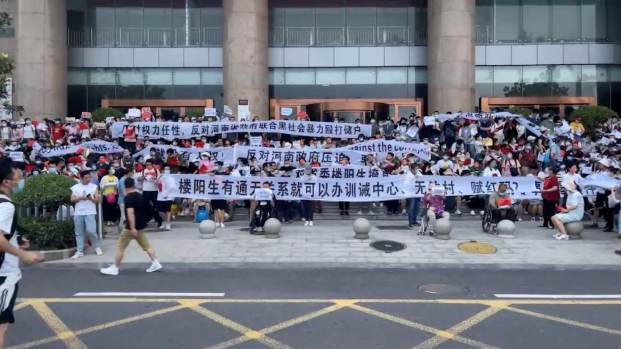A banking scandal at a series of small banks in China’s Henan and Anhui provinces has spooked depositors and may risk broader contagion, rating agency S&P Global warned.
The crisis – which has reportedly left up to 400,000 customers unable to withdraw money from four village banks in Henan and two in Anhui province since mid-April – could cause a “flight-to-quality scenario,” the report by S&P Global Ratings credit analyst Harry Hu said.
That would involve worried bank customers shifting deposits and/or investment products from small to larger banks or those perceived to be backed by governments, it said.
“The fuse for contagion risk could be lit by an adverse turn in public perception rather than strengths or weakness in banking metrics,” the report said. “Banks most vulnerable to panic are those with legacy internet platform dealings with participating non-bank financial institutions. In a contagion scenario, customers may indiscriminately withdraw deposits and investment products.”
Police and banking regulators investigating the scandal say they have detected fraud by parties connected to the six small banks, and there are also charges of stolen assets. Investigators said shareholder-related governance issues in the two provinces had been a problem for more than a decade, the S&P report said.
“A police report from the city of Xuchang [in Henan] cited related-party dealings, undue influence on senior bank managers and outright fraud at the involved banks,” it said.
ALSO SEE: Chinese Officials See Under 200 High-Risk Banks By 2025
Major Protest
A major protest in Henan’s capital Zhenghzhou on Sunday, July 10, by about 1,000 victims of the fraud threw the spotlight on their battle for a better and faster resolution, as well as the weak governance at small banks in China – a problem which was well-known, partly because of the collapse of the Baoshang Bank several years ago.
National regulators have been forced to intervene, because of the need to quell a build-up of social tension and maintain financial stability. That also stemmed from the scale of the crisis – which the report said could cost the government up to 20 billion yuan (nearly $3 billion) in payouts, the report said.
Banking regulators in Henan said they would start making payments from Friday, July 15, to some “affected customers” who made online purchases of “deposit-like” financial products and had accounts of under 50,000 yuan ($7,430).
However, the tricky part of resolving the crisis, as the report notes, is “the affected funds may not be typical customer deposits, but rather investments in wealth management products” and regulators had referred to these funds as “part of the off-balance sheet business of the banks.”
That was why the promised interim payout of up to 50,000 yuan “is not being referred as deposit insurance payout,” it said, as that had a 500,000 yuan cap under the deposit insurance scheme.
“Determining the nature of the misappropriated funds is important because investment funds are not covered under the deposit insurance fund. Some reports are even saying these funds never registered with the bank due to fraud. That could impose legal complications on the victims.
“We believe prudential regulators are assessing potential financial gaps and trying to strike a delicate balance between protecting depositor confidence without being seen to guarantee investment-like products and other concessions that give rise to moral hazard,” the report said.
“In light of the small size of these private banks, the foul play involved, reputation damage suffered, and ordinary deposits becoming affected, a regulatory takeover could be on the table.”
High-Risk Banks
A central bank official who spoke at a news conference on Wednesday, said the number of high-risk banks had been reduced to 316, as of the end of June, and these institutions only accounted for around 1% of banking assets, the report said, citing Sina news.
Rural commercial banks, rural cooperative banks and rural credit unions made up 64% of the high-risk group, and village banks 29%, it said.
“Geographically, Henan has a high representation of financial institutions in the high-risk category. Other provinces include Liaoning, Gansu, Inner Mongolia, Shanxi, Jilin and Heilongjiang.”
- Jim Pollard
ALSO SEE:
Two China Provinces to Repay Depositors After Rare Protests
Canadian Billionaire Xiao Jianhua Faces Trial in China
Baoshang Faces Bankruptcy, China Banking Regulator Says
























